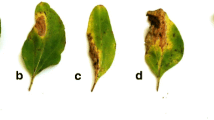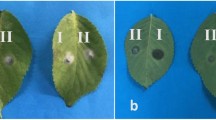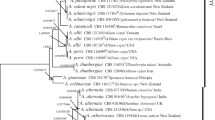Abstract
Brown spot is the most important disease for the culture of cactus prickly pear (Nopalea cochenillifera (L) Salm-Dyck; Cactaceae family), and in many countries, Alternaria spp. are commonly associated with the disease. In Brazil, only three species of Alternaria are associated with brown spot: A. alternata, A. tenuissima, and A. longipes. However, other Alternaria spp. may be involved in the etiology of the disease. This study aimed to identify Alternaria species associated with prickly pear brown spot in Northeast Brazil. Cladodes presenting symptoms of brown spot were collected from three counties in the state of Alagoas and three in the state of Pernambuco. Isolation, obtaining monosporic cultures, and pathogenicity tests were performed. For correct taxonomic positioning of the isolates, morphological and molecular analyses were performed using the internal transcribed spacer (ITS) region and the translation elongation factor 1-alpha (tef1), Alternaria major allergen (Alt a1), glyceraldehyde-3-phosphate dehydrogenase (gapdh), and second largest subunit of RNA polymerase (rpb2). Fourteen pathogenic isolates were obtained, and according to the morphological and molecular analyses, three species of Alternaria were identified: A. gossypina, A. jacinthicola, and A. tomato, all belonging to the Alternata section. A. gossypina, A. jacinthicola, and A. tomato are described for the first time in Nopalea cochenillifera worldwide.



Similar content being viewed by others
References
Andrew, M., Peever, T. L., & Pryor, B. M. (2009). An expanded multilocus phylogeny does not resolve morphological species within the small-spored Alternaria species complex. Mycologia, 101(1), 95–109.
Altschul, S. F., Gish, W., Miller, W., & Myers, E. W. (1990). & Lipman, D.J. (1990). Basic local alignment search tool. Journal of Molecular Biology, 215, 403–410.
Baldauf, S. L., & Palmer, J. D. (1993). Animals and fungi are each other's closest relatives: Congruent evidence from multiple proteins. Proceedings of the National Academy of Sciences, 90(24), 11558–11562.
Barbosa, R. S., Calvalcanti, V. A. L., Lopes, E. B, & Araújo, E. (2012). Doenças da Palma forrageira. In E. B. Lopes (Ed.), Palma forrageira: Cultivo, uso atual e perspectivas de utilização no semiárido nordestino (pp. 81–98). João Pessoa: EMEPA/FAEPA.
Berbee, M. L., Pirseyedi, M., & Hubbard, S. (1999). Cochliobolus phylogenetics and the origin of known, highly virulent pathogens, inferred from ITS and glyceraldehyde-3-phosphate dehydrogenase gene sequences. Mycologia, 91, 964–977.
Castellani, A. (1960). A brief note on the viability of some pathogenic fungi in sterile distilled water. Imprensa Medica Lisbon., 24, 270–272.
Cheney, S. A., Lafranchi-Tristem, N. J., Bourges, D., & Canning, E. U. (2001). Relationships of microsporidian genera, with emphasis on the polysporous genera, revealed by sequences of the largest subunit of RNA polymerase II (RPB1). Journal of Eukaryotic Microbiology, 48(1), 111–117.
Conforto, C., Lima, N. B., Garcete-Gómez, J. M., Câmara, M. P., & Michereff, S. J. (2019). Characterization of fungal species associated with cladode brown spot on Nopalea cochenillifera in Brazil. European Journal of Plant Pathology, 155(4), 1179–1194.
Ding, S., Meinholz, K., Cleveland, K., Jordan, S. A., & Gevens, A. J. (2019). Diversity and virulence of Alternaria spp. causing potato early blight and Brown spot in Wisconsin. Phytopathology, 109(3), 436–445.
Doyle, J., & Doyle, J. L. (1987). A rapid DNA isolation procedure for small quantities of fresh leaf tissue. Bull. Bot. Soc. am. 19: 11–15. Hemphill J, basal H and Wayne C. 2006. Screening method for salt tolerance in cotton. American Journal of Plant Physiology., 1, 107–112.
Edgar, R. C. (2004). MUSCLE: Multiple sequence alignment with high accuracy and high throughput. Nucleic acids research, 32(5), 1792–1797.
Farr, D. F., & Rossman, A. Y. (2019). Fungal database: Fungus-host distributions. http://nt.ars-grin.gov/fungaldatabases/fungushost/fungushost.cfm. Accessed23 Mar 2019.
Feijó, F. M., Silva, M. J., Nascimento, A. D., Infante, N. B., Ramos-Sobrinho, R., Assunção, I. P., & Lima, G. S. A. (2019). Espécies de Botryosphaeriaceae associada ao cacto pickly pickly pear, Nopalea cochenillifera. Tropical Plant Pathology, 44(5), 452–459.
Flores-Flores, R., Velázquez-del Valle, M. G., León-Rodriguez, R., Flores-Moctezuma, H. E., & Hernández-Lauzardo, N. A. (2013). Identification of fungal species associated with cladode spot of prickly pear and their sensitivity to chitosan. Journal of phytopathology, 161(7-8), 544–552.
Gabriel, M. F., Uriel, N., Teifoori, F., Postigo, I., Suñén, E., & Martínez, J. (2017). The major Alternaria alternata allergen, alt a 1: A reliable and specific marker of fungal contamination in citrus fruits. International Journal of Food Microbiology, 257(18), 26–30.
Grum-Grzhimaylo, A. A., Grum-Grzhimaylo, A. A., Georgieva, M. L., Bondarenko, S. A., Debets, A. J., & Bilanenko, E. N. (2016). On the diversity of fungi from soda soils. FungalDdiversity, 76(1), 27–74.
Hong, S. G., Cramer, R. A., Lawrence, C. B., & Pryor, B. M. (2005). Alt a 1 allergen homologs from Alternaria and related taxa: Analysis of phylogenetic content and secondary structure. Fungal Genetics and Biology, 42(2), 119–129.
Hopkins, J. C. F. (1931). "Alternaria gossypina (Thüm.) comb. nov. causing a leaf spot and boll rot of cotton." Transactions of the British Mycological Society 16.2-3: 136-IN4.
Hyde, K. D., Nilsson, R. H., Alias, S. A., Ariyawansa, H. A., Blair, J. E., Cai, L., De Cock, A. W. A. M., Dissanayake, A. J., Glockling, S. L., Goonasekara, I. D., Gorczak, M., Hahn, M., Jayawardena, R. S., Al Van Kan, J. A. L., Laurence, M. H., Lévesque, C. A., Li, X., Liu, J. K., Maharachchikumbura, S. S. N., Manamgoda, D. S., Martin, F. N., Mckenzie, E. H. C., Mctaggart, A. R., Mortimer, P. E., Nair, P. V. R., Pawłowska, J., Rintoul, T. L., Shivas, R. G., Spies, C. F. J., Summerell, B. A., Taylor, P. W. J., Terhem, R. B., Udayanga, D., Vaghefi, N., Walther, G., Wilk, M., Wrzosek, M., Xu, J.-C., Yan, J.-Y., & Zhou, N. (2014). One stop shop: Backbones trees for important pytopathogenic genera: I. Fungal Diversity., 67, 21–125.
Lanfear, R., Frandsen, P. B., Wright, A. M., Senfeld, T., & Calcott, B. (2016). PartitionFinder 2: New methods for selecting partitioned models of evolution for molecular and morphological phylogenetic analyses. Molecular biology and evolution, 34(3), 772–773.
Lawrence, D. P., Park, M. S., & Pryor, B. M. (2012). Nimbya and Embellisia revisited, with nov. comb for Alternaria celosiae and A. perpunctulata. Mycological progress, 11(3), 799–815.
Lawrence, D. P., Gannibal, P. B., Peever, T. L., & Pryor, B. M. (2013). The sections of Alternaria: Formalizing species-group concepts. Mycologia, 105(3), 530–546.
Lawrence, D. P., Gannibal, P. B., Dugan, F. M., & Pryor, B. M. (2014). Characterization of Alternaria isolates from the infectoria species-group and a new taxon from Arrhenatherum, Pseudoalternaria arrhenatheria sp. nov. Mycological progress, 13(2), 257–276.
Lawrence, D. P., Travadon, R., & Baumgartner, K. (2015). Diversity of Diaporthe species associated with wood cankers of fruit and nut crops in northern California. Mycologia, 107(5), 926–940.
Lawrence, D. P., Rotondo, F., & Gannibal, P. B. (2016). Biodiversity and taxonomy of the pleomorphic genus Alternaria. Mycological Progress, 15, 3.
Lima, G. S. A., Assunção, I. P., Martins, R. B., Santos, H. V., & Michereff, S. J. (2011). Development and validation of a standard area diagram set for assessment of Alternaria spot on the cladodes of the prickly pear cactus. Journal of Plant Pathology., 93, 691–695.
Luo, H., Ma, D. F., Sun, Z. X., & Deng, J. X. (2018). First report of leaf spot disease caused by Alternaria jacinthicola on Tagetes erecta in China. Plant disease, 102(11), 2375.
Miller, M.A., Pfeiffer, W., Schwartz T. (2010). Creating the CIPRES science gateway for inference of large phylogenetic trees. In 2010 gateway computing environments workshop (GCE). Nov 14:1–8.
Oliveira, L. F., Feijó, F. M., Mendes, A. L., Neto, J. D., Netto, M. S., Assunção, I. P., & Lima, G. S. (2018). Identification of Colletotrichum species associated with brown spot of cactus prickly pear in Brazil. Tropical Plant Pathology, 43(3), 247–253.
Poudel, B., Velázquez-del Valle, M. G., Hernández-Lauzardo, A. N., & Zhang, S. (2019). First report of Alternaria tomato causing leaf spot on sunflower in Mexico. Plant Disease, 103(5), 1029.
Pryor, B. M., & Gilbertson, R. L. (2000). Molecular phylogenetic relationships amongst Alternaria species and related fungi based upon analysis of nuclear ITS and mt SSU rDNA sequences. Mycological Research, 104(11), 1312–1321.
Pryor, B. M., Creamer, R., Shoemaker, R. A., McLain-Romero, J., & Hambleton, S. (2009). Undifilum, a new genus for endophytic Embellisia oxytropis and parasitic Helminthosporium bornmuelleri on legumes. Botany, 87(2), 178–194.
Rannala, B., & Yang, Z. (1996). Probability distribution of molecular evolutionary trees: A new method of phylogenetic inference. Journal of molecular evolution, 43(3), 304–311.
Reeb, V., Lutzoni, F., & Roux, C. (2004). Contribution of RPB2 to multilocus phylogenetic studies of the euascomycetes (Pezizomycotina, Fungi) with special emphasis on the lichen-forming Acarosporaceae and evolution of polyspory. Molecular Phylogenetics and Evolution, 32(3), 1036–1060.
Rehner, S. (2001). Primers for elongation factor 1-α (EF1-α). Available form: http://ocid.NACSE.ORG/research/deephyphae/EF1primer.pdf (https://www2.clarku.edu/faculty/dhibbett/Protocols_Folder/Primers/Primers.pdf).
Rokas, A., & Carroll, S. B. (2005). More genes or more taxa? The relative contribution of gene number and taxon number to phylogenetic accuracy. Molecular Biology and Evolution, 22(5), 1337–1344.
Ronquist, F., Teslenko, M., Van Der Mark, P., Ayres, D. L., Darling, A., Höhna, S., Larget, B., Liu, L., Suchard, M. A., & Huelsenbeck, J. P. (2012). MrBayes 3.2: Efficient Bayesian phylogenetic inference and model choice across a large model space. Systematic biology, 61(3), 539–542.
Santos, D. C., Santos, M. V., Farias, I., Dias, F. M., & Lira, M. D. (2001). Desempenho produtivo de vacas 5/8 holando/zebu alimentadas com diferentes cultivares de palma forrageira (Opuntia e Nopalea). Revista Brasileira de Zootecnia., 30(1), 12–17.
Siciliano, I., Ortega, S. F., Gilardi, G., Bosio, P., Garibaldi, A., & Gullino, M. L. (2018). Molecular phylogeny and characterization of secondary metabolite profile of plant pathogenic Alternaria species isolated from basil. Food Microbiology, 73, 264–274.
Silva, L. M., Silva, L. M., Fagundes, J. L., Viegas, P. A., Muniz, E. N., Rangel, J. H., Moreira, A. L., & Backes, A. A. (2014). Produtividade da Palma Forrageira cultivada em diferentes densidades de plantio. Ciência Rural, 44(11), 2064–2071.
Simmons, E. G. (1967). Typification of Alternaria, Stemphylium, and Ulocladium. Mycologia, 59(1), 67–92.
Simmons, E. G. (1971). Helminthosporium allii as type of a new genus. Mycologia, 63(2), 380–386.
Simmons, E. G. (1989). Macrospora Fuckel (Pleosporales) and related anamorphs. Sydowia., 41, 314–329.
Simmons, EG. (1992). Alternaria taxonomy: Current status, viewpoint, challenge. Alternaria biology. Plant diseases and metabolites.:1-35.
Simmons, E. G. (2007). Alternaria. An identification manual. In: CBS biodiversity series 6. CBS Fungal Biodiversity Centre, Utrecht, The Netherlands.
Shinha, K.K., & Bhatnagar, D. (1998). Mycotoxins in agriculture and food safety. CRC Press, 1998.
Souza, A. E. F., Nascimento, L. C., Araújo, E., Lopes, E. B., & Souto, F. M. (2010). Ocorrência e identificação dos agentes etiológicos de doenças em palma forrageira (Opuntia fícus-indica Mill.) no semiárido paraibano. Revista Biotemas., 23(3), 11–20.
Stiller, J. W., & Hall, B. D. (1997). The origin of red algae: Implications for plastid evolution. Proceedings of the National Academy of Sciences, 94(9), 4520–4525.
Tamura, K., Stecher, G., Peterson, D., Filipski, A., & Kumar, S. (2013). MEGA6: Molecular evolutionary genetics analysis version 6.0. Molecular Biology and Evolution. (30):2725–2729.
White, T. J., Bruns, T., Lee, S., & Taylor, J. (1990). Amplification and direct sequencing of fungal ribosomal RNA genes for phylogenetics. In M. A. Innis, D. H. Gelfand, J. J. Snisky, & T. J. White (Eds.), PCR, Guia de métodos e aplicações (pp. 315–322). San Diego: Academic Press.
Woudenberg, J. H., Groenewald, J. Z., Binder, M., & Crous, P. W. (2013). Alternaria redefined. Studies in mycology, 75, 171–212.
Woudenberg, J. H., Seidl, M. F., Groenewald, J. Z., De Vries, M., Stielow, J. B., Thomma, B. P., & Crous, P. W. (2015). Alternaria section Alternaria: Species, formae speciales or pathotypes. Studies in Mycology., 82, 1–21.
Acknowledgments
This work was supported by Fundação de Amparo à Pesquisa de Alagoas – FAPEAL. We also thank the Coordenação de Aperfeiçoamento de Pessoal de Nível Superior – CAPES for a masters fellowiship.
Author information
Authors and Affiliations
Corresponding author
Ethics declarations
This research article is not submitted elsewhere for publication and this manuscript complies with the Ethical Rules applicable for this journal.
Ethical statement
This article does not contain any studies with human participants or animals performed by any of the authors.
Conflict of interest
The authors declare that they have no competing interest.
Supplementary Information
ESM 1
(PDF 418 kb)
Rights and permissions
About this article
Cite this article
Infante, N.B., da Silva, G.C.S., Feijó, F.M. et al. Alternaria species associated with cladode brown spot in cactus prickly pear (Nopalea cochenillifera). Eur J Plant Pathol 160, 215–226 (2021). https://doi.org/10.1007/s10658-021-02236-5
Accepted:
Published:
Issue Date:
DOI: https://doi.org/10.1007/s10658-021-02236-5




